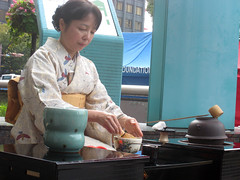The Japanese tea ceremony is a wonderful way to practice meditation. It’s a great idea for coffee breaks at home or work. This is a quick and easy version for one person I’ve adapted using things you already have on hand: a drink (ideally something bitter, such as tea or coffee, but water’s ok, too) and finger sweets (ex., cookies, fig bars, brownies, Rice Krispies Treats).
Take your things to a quiet sitting area.
Your quiet sitting area could be a table and chair or a pillow on the floor in your office, home, patio, gazebo, garden or poolside. Whatever works for you to face the cup, focus and relax, free of distraction, which is the ultimate goal of the Japanese tea ceremony and any meditation.
- Get settled and focus on your breathing.
- Slowly turn your drink three times clockwise.
- Lifting from the elbows, bring the drink to your lips and sip slowly.
- Balance the flavor of your drink by enjoying your sweets.
- Continue to focus on your breathing while drinking and eating slowly.
- On the last sip, make a slurping sound to acknowledge the glass or cup is empty.
- Take this time to admire the beauty of the drink container.
- Slowly turn your drink container once counterclockwise to conclude that serving.
- If the situation allows, you may refill your beverage after each counterclockwise turn until you are done with the Japanese tea ceremony.
To enhance your meditation and comfort, you can play conducive music during your ceremony. Look into the massage, meditation, nature, Zen and space music genres. There is actually Japanese tea ceremony music, too.
While this ceremony is designed for solo practice, if you have a friend who’d appreciate joining you in this celebration of peace, go for it.
Enhance this contemplative time by embracing your faith or a positive affirmation. Many, if not all, world religions have ideas and practices which lend themselves well to meditation. This is a golden opportunity to unite with friends of like faith or create your own inter-faith circle, honoring this commonality in your creeds and celebrating the differences as flowers in a garden or coffees and teas.
In time, I’ll add more in-depth Japanese and English tea ceremonies, meditations and maybe even some music, recipes and equipage recommendations. Stay tuned and thank you for reading.
RELATED:
Meditation: What is Meditation?
Meditation: Benefits of Meditation
Belinda Y. Hughes is a lifestyle coach and freelance writer. She is a Certified Yoga Teacher (CYT) and retired Licensed Massage Therapist (LMT). Her vegetarian cookbook, Confessions of a Red Hot Veggie Lover 2, has made the Amazon Top 100 a few times.





